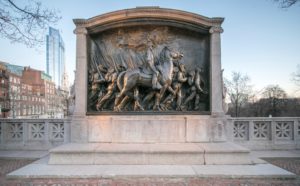During the American Civil War, Fort Wagner was a Confederate stronghold that protected the harbor of Charleston, then the largest city in South Carolina. The fortress walls were made of sand and earth, and stood over 30 feet tall, and the fort itself was protected by a moat five feet deep and ten feet wide that was surrounded by land mines and stakes. Inside were fourteen cannons and room for up to one thousand of the seventeen hundred Confederate soldiers stationed there.
The First Battle of Fort Wagner took place on July 11, 1863, when Union forces led by Brigadier General Quincy Gillmore, attempted unsuccessfully to capture the fort. Gillmore and his troops retreated to Union-controlled beachfront trenches, regrouped, and planned a second attack the following week.
On the morning of July 18, Gillmore began his second attack, ordering Union artillery forces from warships three hundred yards away to commence firing on the fort. Soldiers of the 54th Massachusetts Infantry Regiment, commanded by 25-year-old Colonel Robert Gould Shaw, were chosen to lead the ground assault. The 54th consisting of over 1,000 African American men led by 37 white officers, was the first officially recognized black Union military regiment in the Civil War. Two other black regiments preceded it, the First Kansas Colored Infantry organized in August 1862, and the First South Carolina Volunteer Infantry, in November 1862, but the 54th was officially sanctioned by the Lincoln Administration’s War Department. The 54th was backed in the assault on Fort Wagner by nine other undermanned regiments totaling approximately 4,400 federal troops.

The attack began in two movements, with the 54th moving up the west side of the fort and the remaining units attacking the south side. The 54th deployed for the assault on Fort Wagner in two lines of five companies each, followed by the remainder of the unit. They stormed and captured the outer rifle pits surrounding the fort. Colonel Shaw then led the men through the moat and up the side wall to the parapet. When Colonel Shaw reached the top, he waved his sword and called “Onward Fifty Fourth!” Just at that moment he was struck and killed by gunfire. The soldiers of the 54th were soon beaten back after hand to hand combat with Confederate soldiers at the parapet and along the walls.
From the beach, other Union forces tried to move forward to support the 54th but were defeated and forced to withdraw. Colonel Shaw and 30 soldiers of the 54th died during the assault on Fort Wagner. Twenty-four soldiers later died because of wounds they received in the assault, 15 were captured, and 52 were listed as missing in action. Private Lewis Henry Douglass, son of abolitionist Frederick Douglass, was wounded but later recovered. Sgt. William Carney of the 54th recovered the U.S. flag during the assault and returned it to Union lines. For his overall heroism at Fort Wagner, he became the first African American soldier to receive the Medal of Honor from the United States Congress.
After over eight hours of fighting, Union forces were forced to end their attempt to capture Fort Wagner. The Confederates held the Fort until September 7, 1863, when they abandoned it after over sixty days of constant Union shelling of the structure.

